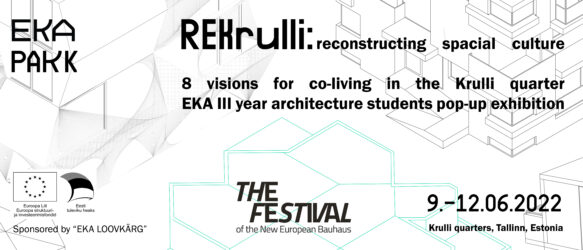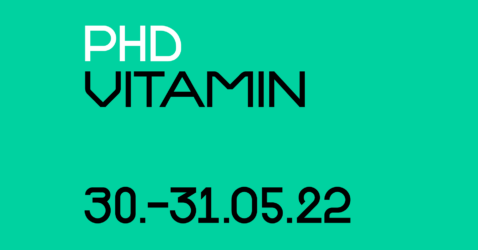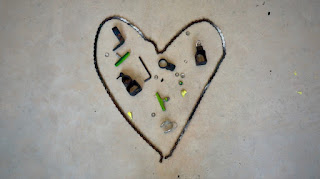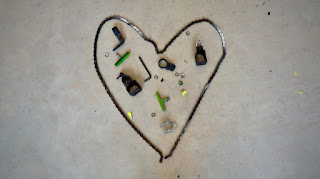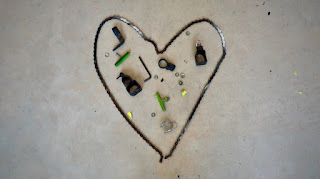Events
27.05.2022 — 09.06.2022
EKA Grad Show ’22
TASE’22
Estonian Academy of Arts Grad Show
28.05–09.06, open daily 12–6 pm
Opening: 27.05, 4pm @EKA
Exhibition locations:
EKA, Põhja pst 7
Vent Space, Vabaduse väljak 6-8
ARS Art Factory, Pärnu mnt 154
Rotermanni kvartal, Rotermanni 7
TASE is the annual graduation show of the Estonian Academy of Arts. It presents the final projects of Fine Arts, Architecture, Design, and Art and Culture faculties’ master’s students, along with the final artworks by Fine Arts and Design faculties’ bachelor’s students. The opening of the main exhibition and TASE’22 webpage tase.artun.ee takes place on May 27th at 4 pm at EKA!
Most of the works are exhibited at EKA on all five floors and including EKA Gallery and Billboard Gallery. Additionally, you can visit the exhibition at ARS Art Factory (Project Space, Showroom and room 112), Vent Space, Rotermanni 7, Lai 31, Kanuti Gildi Hall Cellar, Kadriorg Art Museum, Poordi 3 and Loewenschede tower on Kooli str 7. See more info on the programme.
tase.artun.ee opens simultaneously with the main exhibition on May 27th!
In addition to the works at the main exhibition, written theses by PhD and Art and Culture graduates and grad works from the rest of the BA graduates will be presented on tase.artun.ee. Last year’s TASE page can be found at tase20.artun.ee and tase21.artun.ee.
Young Artist Award and Young Applied Artist Award
The Young Artist Award and Young Applied Artist Award winners at the master’s and bachelor’s levels will be announced at the opening of TASE main exhibition. The prizes are each 1500€.
Young Artist Award winner at the master’s level will be chosen from Contemporary Art graduation works and at the bachelor’s level from the Graphic Art, Installation and Sculpture Painting, and Photography graduation works. The master’s prize includes a solo exhibition at the Hobusepea or Draakon gallery in 2023. This year’s jury members are art professionals Elin Kard, Marko Mäetamm, Aleksander Zahharov, Karolin Poska (only MA), Sigrid Viir and Maarin Ektermann.
Young Applied Artist Award winners will be selected from the Design and Crafts graduation works. The master level prize includes a solo exhibition at the HOP Gallery. The jury members are Maria Valdma, Ketli Tiitsar, Gregor Taul, Keiu Krikmann and Tiina Sarapu.
PROGRAMME
Exhibition opening ceremony
27.05 at 16.00, EKA lobby
Theses defences
30.05–15.06, www.artun.ee/kaitsmised
TASE FILM
04.06 at 17.00, A101
Scenography bachelors’ works exhibition “Kujundliku Mõtte Labor”
Estookin, Kristel Zimmer, Anita Kremm, Linda Mai Kari, Liisamari Viik, supervisor Ene-Liis Semper
28.05–07.06, open every day at 12.00–18.00, opening on 27.05 at 18.00
Lai 31, II floor
Graphic Design master’s graduation works “Silence After Early Hours”
Mucho Mustachio (Alejandro Bellón Ample), Louise Borinski, Daddy Breezy (Aleksandrs Breže), Energy Star (Paula Buškevica), Reese (Björn Giesecke), Tropaasi (Otso Peräsaari), Foxy (Diandra Rebase), miss S (Katarina Sarap)
04–11.06 at 13.00–19.00
Opening 03.06 at 18.00, finissage 11.06 at 21.00
Kanuti Guild Hall Cellar, Pühavaimu 5
www.silenceafterearlyhours.eka-gd-ma.ee
“Piiritu”, curator Nele Ambos
Cultural Heritage and Conservation master’s graduation work
Lilly Walther
23.02–29.05, Wed, Fri-Sun at 11.00–18.00, Thu at 11.00–20.00
Tartu Art Museum, Raekoja plats 18, Tartu
“ars viva 2022 – tajuvälja agendid”, curator Maria Helen Känd
Curator studies master’s graduation work
Tamina Amadyar, Laura Põld, Lewis Hammond, Jānis Dzirnieks, Anastasia Sosunova, Mooni Perry
09.04–07.09, Wed-Sun at 12.00–18.00
Kai kunstikeskus, Peetri 12
“Visible Storage Gallery for the Sculpture Collection”, curator Maria Väinsar
Department of Cultural Heritage and Conservation, master’s thesis
18.05.2022–31.12.2024
Tue, Thu-Sun at 10.00–18.00, Wed at 10.00–20.00
Kadriorg Art Museum, Weizenbergi 37, 10127 Tallinn
Olev Kuma “Transmission”
Painting bachelor’s graduation work
28.05–09.06, every day at 11.00–19.00
Poordi 3
Caroline Pajusaar “Inferno”
Bachelor’s thesis in Graphics
27.05–10.06, Mon-Fri at 11.00–18.00
Loewenschede tower, Kooli 7 (entrance from the park, last floor)
SATELLITE PROGRAMME
Open Academy exhibition “Maalikunsti A, B, C… ja Z lõputööde näitus”
Kaia Hommik, Ivo Kuldmäe, Anne-Mari Rannamäe, Jana Koel, Gerli Pesor, Andri Lõhek, Mari-Helen Vili, Kristine-Kristi Kasak, Ülle Soitu, Astrid Mägi, Mari Annuka, Raili Moldov
20.05–28.05, Wed-Fri at 12.00–18.00, Sat at 12.00–16.00, opening 19.05 at 18.00
Artdepoo gallery, Jahu 12-213
Jewellery and Blacksmithing II year student exhibition “NIHE”
Anna-Maria Vaino, Ardo Teesalu, Bianca Triinu Toots, Hugo Toss, Margus Elizarov, Villu Mustkivi, Visa Eino Eduard Nurmi, Ellen Axberg, Camilla Prey
20.05–02.06 at 12.00–20.00, opening 19.05 at 18.00
Uus 4
Photoart Academy exhibition “Ruumis”
Marcus Kallavus, Marta Khrshanovskaya, Silvi Kiin, Elias Kuulmann, Kristi Leps, Margus Metsaäär, Jaanus Muruõis, Nelli Pello, Kärt Petser, Annika Vihmann
Open 24/7, opening 07.06 at 18.00,
Telliskivi 64
Head organiser: Pire Sova
Assistant: Dana Lorên Vares
Exhibition design: Brigit Arop, Katarina Ild, Anabel Ainso
Communication: Solveig Jahnke, Andres Lõo, Maarja Pabut
Graphic design: Birgita Siim, Agnes Isabelle Veevo, Aaro Veiderpass
Web coordinator: Kert Väljak
TASE FILM and opening event: Johanna Kuzmenko, Ligia Fernandes
Supported by Eesti Kultuurkapital, Kasevetekohin, Mistra, AkzoNobel, BigBerry
EKA Grad Show ’22
Friday 27 May, 2022 — Thursday 09 June, 2022
TASE’22
Estonian Academy of Arts Grad Show
28.05–09.06, open daily 12–6 pm
Opening: 27.05, 4pm @EKA
Exhibition locations:
EKA, Põhja pst 7
Vent Space, Vabaduse väljak 6-8
ARS Art Factory, Pärnu mnt 154
Rotermanni kvartal, Rotermanni 7
TASE is the annual graduation show of the Estonian Academy of Arts. It presents the final projects of Fine Arts, Architecture, Design, and Art and Culture faculties’ master’s students, along with the final artworks by Fine Arts and Design faculties’ bachelor’s students. The opening of the main exhibition and TASE’22 webpage tase.artun.ee takes place on May 27th at 4 pm at EKA!
Most of the works are exhibited at EKA on all five floors and including EKA Gallery and Billboard Gallery. Additionally, you can visit the exhibition at ARS Art Factory (Project Space, Showroom and room 112), Vent Space, Rotermanni 7, Lai 31, Kanuti Gildi Hall Cellar, Kadriorg Art Museum, Poordi 3 and Loewenschede tower on Kooli str 7. See more info on the programme.
tase.artun.ee opens simultaneously with the main exhibition on May 27th!
In addition to the works at the main exhibition, written theses by PhD and Art and Culture graduates and grad works from the rest of the BA graduates will be presented on tase.artun.ee. Last year’s TASE page can be found at tase20.artun.ee and tase21.artun.ee.
Young Artist Award and Young Applied Artist Award
The Young Artist Award and Young Applied Artist Award winners at the master’s and bachelor’s levels will be announced at the opening of TASE main exhibition. The prizes are each 1500€.
Young Artist Award winner at the master’s level will be chosen from Contemporary Art graduation works and at the bachelor’s level from the Graphic Art, Installation and Sculpture Painting, and Photography graduation works. The master’s prize includes a solo exhibition at the Hobusepea or Draakon gallery in 2023. This year’s jury members are art professionals Elin Kard, Marko Mäetamm, Aleksander Zahharov, Karolin Poska (only MA), Sigrid Viir and Maarin Ektermann.
Young Applied Artist Award winners will be selected from the Design and Crafts graduation works. The master level prize includes a solo exhibition at the HOP Gallery. The jury members are Maria Valdma, Ketli Tiitsar, Gregor Taul, Keiu Krikmann and Tiina Sarapu.
PROGRAMME
Exhibition opening ceremony
27.05 at 16.00, EKA lobby
Theses defences
30.05–15.06, www.artun.ee/kaitsmised
TASE FILM
04.06 at 17.00, A101
Scenography bachelors’ works exhibition “Kujundliku Mõtte Labor”
Estookin, Kristel Zimmer, Anita Kremm, Linda Mai Kari, Liisamari Viik, supervisor Ene-Liis Semper
28.05–07.06, open every day at 12.00–18.00, opening on 27.05 at 18.00
Lai 31, II floor
Graphic Design master’s graduation works “Silence After Early Hours”
Mucho Mustachio (Alejandro Bellón Ample), Louise Borinski, Daddy Breezy (Aleksandrs Breže), Energy Star (Paula Buškevica), Reese (Björn Giesecke), Tropaasi (Otso Peräsaari), Foxy (Diandra Rebase), miss S (Katarina Sarap)
04–11.06 at 13.00–19.00
Opening 03.06 at 18.00, finissage 11.06 at 21.00
Kanuti Guild Hall Cellar, Pühavaimu 5
www.silenceafterearlyhours.eka-gd-ma.ee
“Piiritu”, curator Nele Ambos
Cultural Heritage and Conservation master’s graduation work
Lilly Walther
23.02–29.05, Wed, Fri-Sun at 11.00–18.00, Thu at 11.00–20.00
Tartu Art Museum, Raekoja plats 18, Tartu
“ars viva 2022 – tajuvälja agendid”, curator Maria Helen Känd
Curator studies master’s graduation work
Tamina Amadyar, Laura Põld, Lewis Hammond, Jānis Dzirnieks, Anastasia Sosunova, Mooni Perry
09.04–07.09, Wed-Sun at 12.00–18.00
Kai kunstikeskus, Peetri 12
“Visible Storage Gallery for the Sculpture Collection”, curator Maria Väinsar
Department of Cultural Heritage and Conservation, master’s thesis
18.05.2022–31.12.2024
Tue, Thu-Sun at 10.00–18.00, Wed at 10.00–20.00
Kadriorg Art Museum, Weizenbergi 37, 10127 Tallinn
Olev Kuma “Transmission”
Painting bachelor’s graduation work
28.05–09.06, every day at 11.00–19.00
Poordi 3
Caroline Pajusaar “Inferno”
Bachelor’s thesis in Graphics
27.05–10.06, Mon-Fri at 11.00–18.00
Loewenschede tower, Kooli 7 (entrance from the park, last floor)
SATELLITE PROGRAMME
Open Academy exhibition “Maalikunsti A, B, C… ja Z lõputööde näitus”
Kaia Hommik, Ivo Kuldmäe, Anne-Mari Rannamäe, Jana Koel, Gerli Pesor, Andri Lõhek, Mari-Helen Vili, Kristine-Kristi Kasak, Ülle Soitu, Astrid Mägi, Mari Annuka, Raili Moldov
20.05–28.05, Wed-Fri at 12.00–18.00, Sat at 12.00–16.00, opening 19.05 at 18.00
Artdepoo gallery, Jahu 12-213
Jewellery and Blacksmithing II year student exhibition “NIHE”
Anna-Maria Vaino, Ardo Teesalu, Bianca Triinu Toots, Hugo Toss, Margus Elizarov, Villu Mustkivi, Visa Eino Eduard Nurmi, Ellen Axberg, Camilla Prey
20.05–02.06 at 12.00–20.00, opening 19.05 at 18.00
Uus 4
Photoart Academy exhibition “Ruumis”
Marcus Kallavus, Marta Khrshanovskaya, Silvi Kiin, Elias Kuulmann, Kristi Leps, Margus Metsaäär, Jaanus Muruõis, Nelli Pello, Kärt Petser, Annika Vihmann
Open 24/7, opening 07.06 at 18.00,
Telliskivi 64
Head organiser: Pire Sova
Assistant: Dana Lorên Vares
Exhibition design: Brigit Arop, Katarina Ild, Anabel Ainso
Communication: Solveig Jahnke, Andres Lõo, Maarja Pabut
Graphic design: Birgita Siim, Agnes Isabelle Veevo, Aaro Veiderpass
Web coordinator: Kert Väljak
TASE FILM and opening event: Johanna Kuzmenko, Ligia Fernandes
Supported by Eesti Kultuurkapital, Kasevetekohin, Mistra, AkzoNobel, BigBerry
09.06.2022 — 12.06.2022
Exhibition “REKrulli: Reconstructing spatial culture”
On Thursday, June 9, at 6 pm, we will open an exhibition of works by architecture students of the Estonian Academy of Arts in the Krull Quarter. In the evening, the first introduction of the Timber Architecture Research Center PAKK will take place.
The pop-up exhibition “REKrulli: reconstructing spacial culture” is an official side event of the New European Bauhaus Festival and it will remain open until June 12.
The REKrulli studio’s objective was to develop flexible architecture from sustainable materials, based on digital design and fabrication. We were looking at possible ways of living together beyond the usual apartment association home ownership model, while developing contemporary building structures that can produce adaptable and efficient solutions for the creation of high quality spaces with a positive environmental impact.
REKrulli superstudio supports the ongoing research project “sLender” at EKA PAKK which examines what type of apartment building does Tallinn need today and how to solve a new apartment building using the best knowledge of the Estonian wooden house industry and architects.
SCHEDULE OF THE OPENING EVENT:
15.00 Presentations of the five best works of the Estonian Pavilion of the Venice Architecture Biennale *
17.30 Opening of the installation “Steampunk” *
Exhibition:
18.00 Introduction of the EKA Wooden Architecture Competence Center PAKK, researchers and guests speak.
18.30 Students of the Faculty of Architecture of EKA will present the visions of apartment buildings and the results of the REKrull superstudio.
THE EXHIBITION IS OPEN:
Thursday, June 9, 6 p.m. – Opening night
Friday, June 10, 10 a.m. to 6 p.m.
Saturday, June 11, from 10 a.m. to 6 p.m.
Sunday, June 12, 10 a.m. to 4 p.m.
Students:
Triinu Amboja, Mariia Babur, Grete Daut, Simon Eiland, Roosmarii Kukk, Helin Kuldkepp, Patrick Liik, Kristina Lillepea, Maria Helena Luiga, Mattias Ots, Mariia Paslova, Yelyzaveta Perel, Yelyzaveta Peresada, Daria Polonska, Anna Pushkarska, Mikael Ristmets, Martin Sepp, Sander Sinnep, Kaari Maria Tirmaste, Cristin Marii Titma, Aneth Traumann, Mariia Ufimtseva, Liispet Viira, Laura Liis Vilbiks, Dalia Viškelyt
Tutors:
Architectural planning: Siim Tuksam, Sille Pihlak
Structural analysis and energy design: Adam Orlinski (Bollinger+Grohmann)
Anthropological analysis: Mattias Malk
Landscape architecture: Karin Bachmann
* The opening of the exhibition will be preceded at 3 pm by the public presentations of the five best works of the Estonian Pavilion for the Venice Architecture Biennale and the opening of the installation “Steampunk” in the Krull Quarter. The event is organized by the Estonian Center of Architecture.
Exhibition “REKrulli: Reconstructing spatial culture”
Thursday 09 June, 2022 — Sunday 12 June, 2022
On Thursday, June 9, at 6 pm, we will open an exhibition of works by architecture students of the Estonian Academy of Arts in the Krull Quarter. In the evening, the first introduction of the Timber Architecture Research Center PAKK will take place.
The pop-up exhibition “REKrulli: reconstructing spacial culture” is an official side event of the New European Bauhaus Festival and it will remain open until June 12.
The REKrulli studio’s objective was to develop flexible architecture from sustainable materials, based on digital design and fabrication. We were looking at possible ways of living together beyond the usual apartment association home ownership model, while developing contemporary building structures that can produce adaptable and efficient solutions for the creation of high quality spaces with a positive environmental impact.
REKrulli superstudio supports the ongoing research project “sLender” at EKA PAKK which examines what type of apartment building does Tallinn need today and how to solve a new apartment building using the best knowledge of the Estonian wooden house industry and architects.
SCHEDULE OF THE OPENING EVENT:
15.00 Presentations of the five best works of the Estonian Pavilion of the Venice Architecture Biennale *
17.30 Opening of the installation “Steampunk” *
Exhibition:
18.00 Introduction of the EKA Wooden Architecture Competence Center PAKK, researchers and guests speak.
18.30 Students of the Faculty of Architecture of EKA will present the visions of apartment buildings and the results of the REKrull superstudio.
THE EXHIBITION IS OPEN:
Thursday, June 9, 6 p.m. – Opening night
Friday, June 10, 10 a.m. to 6 p.m.
Saturday, June 11, from 10 a.m. to 6 p.m.
Sunday, June 12, 10 a.m. to 4 p.m.
Students:
Triinu Amboja, Mariia Babur, Grete Daut, Simon Eiland, Roosmarii Kukk, Helin Kuldkepp, Patrick Liik, Kristina Lillepea, Maria Helena Luiga, Mattias Ots, Mariia Paslova, Yelyzaveta Perel, Yelyzaveta Peresada, Daria Polonska, Anna Pushkarska, Mikael Ristmets, Martin Sepp, Sander Sinnep, Kaari Maria Tirmaste, Cristin Marii Titma, Aneth Traumann, Mariia Ufimtseva, Liispet Viira, Laura Liis Vilbiks, Dalia Viškelyt
Tutors:
Architectural planning: Siim Tuksam, Sille Pihlak
Structural analysis and energy design: Adam Orlinski (Bollinger+Grohmann)
Anthropological analysis: Mattias Malk
Landscape architecture: Karin Bachmann
* The opening of the exhibition will be preceded at 3 pm by the public presentations of the five best works of the Estonian Pavilion for the Venice Architecture Biennale and the opening of the installation “Steampunk” in the Krull Quarter. The event is organized by the Estonian Center of Architecture.
19.05.2022
“Preservation: Architecture, Nature and Politics” studio final presentations in Pärnu
Preservation has achieved cultural significance as a lens through which various urban experts have come
to imagine what a socially and environmentally sound future might look like. As an approach, preservation has been applied to disparate phenomena ranging from historic neighbourhoods and natural environments to democracy and identity. This studio unfolded the formative concepts and historic moments that define contemporary understandings of preservation and applied these discussions to various typologies of architecture, urban fabric and the natural environment taking Pärnu and the wider region as a case study. In particular, the studio focused on the ways in which ideas, labour and design have intersected in the past to identify alternatives to the mainstream forms of preservation.
The studio culminates with a presentation of group projects that explore a variety of approaches to layers of heritage and questions of preservation in Pärnu and Sindi. Pärnu, the fourth largest city in Estonia, is struggling with the seemingly conflicting and contradictory notions of growth, shrinkage, preservation and destruction. Sindi, as a smaller town in the region, faces similar, but also additional challenges connected to its significant industrial heritage. Efforts to imagine and construct a vision for a city are also tied up with the tactile practices of preservation; set within specific administrative and management frameworks of maintenance, care, and neglect.
Despite intentions, prescriptive visions by the city and developers can serve to exacerbate inequalities through the various infrastructures, supply chains, policies and environmental conditions that extend well beyond the rigid borders of a city.
Can the concept of preservation open a discussion around a vision for Pärnu (and its hinterlands)
beginning not with growth and progress, but rather with repair, maintenance or even deterioration?
Student projects explore who gets to decide what is valuable, organise the preservation of things, and who then carries out the work. Negotiations about what should be preserved and what “good preservation” entails, are always contingent and contextual.
Projects:
-
- Decompressed Transition: Paula Veidenbauma, Nora Soo and Jannik Kastrup
- Tides of a Summer City: Khadeeja Farrukh, Anna Dzebliuk and Christian Hörner
- Fabricated Heritage – Interweaving the Past and Future of Sindi’s Kalevivabrik: Luca Riese Ritter, Paulina Schroeder and Augustas Lapinskas
- Tea, Coffee or Hot Water?: What to Make of the Boiler Room: Kush Badhwar, Nabeel Imtiaz and Paul Simon
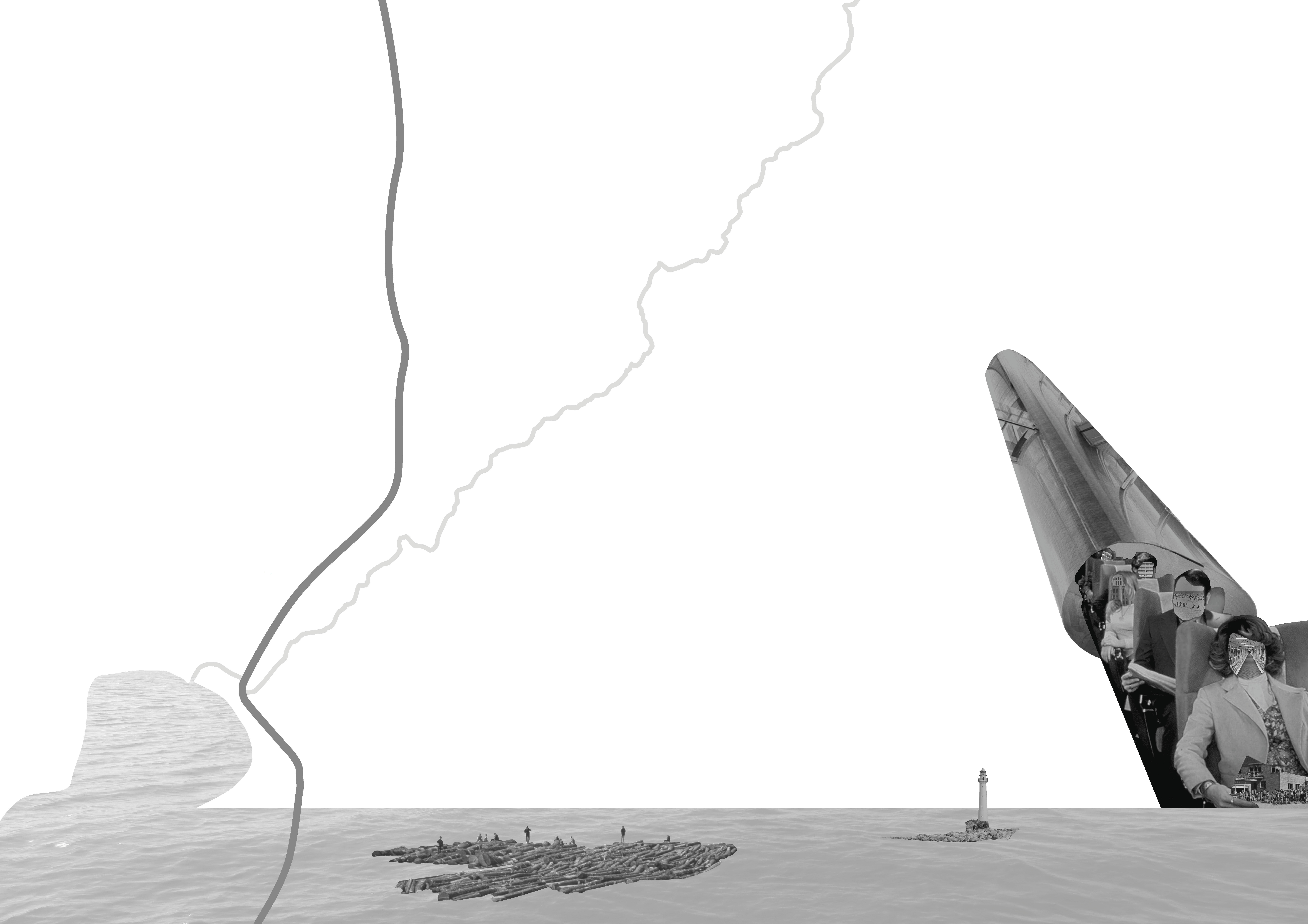 Decompressed Transition
Decompressed Transition
Paula Veidenbauma, Nora Soo and Jannik Kastrup
Pärnu is caught between diverging time regimes. In its role as a major spa and resort town, the city aims at slowing down the rhythm of life of the urban workforce. In parallel, the developments surrounding Rail Baltica will likely greatly compress this rhythm within Pärnu. The project examines frameworks of the relationship between those phenomena. It deals with instances of built and immaterial heritage and acts of preserving, especially the latter through shifting political systems. The float, emerging as the central piece of the project, can be interpreted as a gradient operating between Rail Baltica (a linear and high-velocity infrastructure), Pärnu’s leisure facilities and the open sea. It might function as a means of transportation while also exploring the possibility of non-arrival.
Visitors will be engaging with the project via a video installation, a float building workshop and a presentation. Float building instructions will be summarised in a booklet.
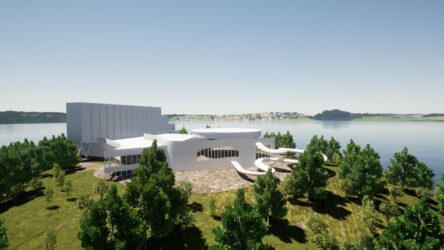 Tides of a Summer City
Tides of a Summer City
Khadeeja Farrukh, Anna Dzebliuk and Christian Hörner
The project explores possible resilient futures in Pärnu as a resort city. Showing how the “Summer City” developed historically, the video installation extrapolates empirical insights through Pärnu’s present-day reality into a future of constant flood emergency. The installation mobilizes futuristic renderings of possible resilient futures after a catastrophic flooding event to juxtapose and question the concepts of heritage, seasonality and resilience. We touch upon the inter-urban dependencies between Pärnu and Tallinn, manifesting historically, materially and spatially at the seaside of Estonia’s summer capital, securing the cities influx of holidaymakers during summer, but also causing issues of urban disenfranchisement of its residents, exploitation of its workers and destruction of coastal habitats of non-human residents. Looking into the future, it will no longer be possible to brush over the threat of flooding and the prospect of permanent crisis. The project “Tides of a Summer City” asks hypothetical questions, working towards a framework for understanding future challenges by following the changing historical tides of a summer city.
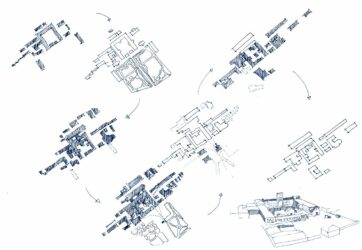
Fabricated Heritage – Interweaving the Past and Future of Sindi’s Kalevivabrik
Luca Riese Ritter, Paulina Schroeder and Augustas Lapinskas
The project explores the significance of Sindi´s industrial heritage. In recent decades, globalisation, deindustrialization, economic restructuring and industrial relocation have produced new landscapes within many European cities and towns – the post-industrial landscape. Deprived of their raison d’être, they are often regarded as spatially, socially, and semiotically empty places. In order to overcome this apparent ‘void’, the transformation of these post-industrial remnants into new uses is now an essential part of urban development practice.
Turning to industrial landscapes as potential carriers of cultural heritage ostensibly provides a framework for the continued management of these sites. Industrial heritage then becomes the bearer of local identity and creates uniqueness out of the former mundane.
The town of Sindi, a place essentially born from the settlement of a textile factory in the early 19th century, is in the process of discussing the reintegration of the material remains of industrial production into the town’s fabric which, since the closure of Kalevivabrik, the textile factory, has outgrown its original purpose. In this process of readjusting the relationship between factory-gone-ruin and the reorientation of the city, our project seeks to understand the potentials and conflicts that arise from industrial heritage, while taking a critical perspective at the practices of heritage preservation and its political implications. How and by whom is the town’s history preserved and remembered? Can there be a value of the material remains in the process of their decay? What is the role of heritage as a legal imperative? What role can the factory building play in the future of Sindi?
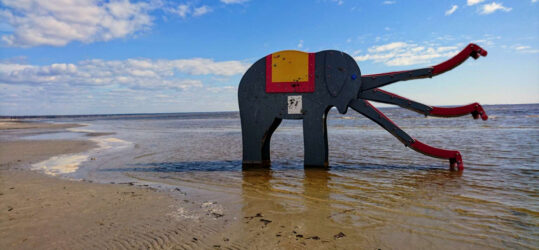 Tea, Coffee or Hot Water?: What to Make of the Boiler Room
Tea, Coffee or Hot Water?: What to Make of the Boiler Room
Kush Badhwar, Nabeel Imtiaz and Paul Simon
Drawing on the interest in the role of the educational institution Academia Non-Grata, elephants and other far-out references, the project explores junctions between the plan, the script and performance; preservation, the boiler room in the wider fabric of Pärnu; and the pitfalls and possibilities of experimental approaches to planning.
Plans for places chart a set of intentions that seek to influence the future of a place. Could the duration in which a plan is enacted be considered a performance?
Conversely, the script may be considered the plan for a performance. But despite the presence of a script, in performance, there can be room to manoeuvre in and around what is on the page, to improvise, to confront uncertainty and the yet to be known, to discover and learn from the process. Could such an approach also be applied to planning a city?
What might be discovered about prospective futures, preservation and other possibilities in Pärnu through the act of performance? Can performance and planning ever effectively speak to one another?
The possibilities of these questions are explored through three intertwined narratives of the boiler room, also the site of performance/presentation of the work: one in which the boiler room remains, structurally, as it is today; another in which the boiler room retains its shell but is appropriated over time; and, lastly in which the boiler room is razed and the site changes in purpose. Speculative fiction and alternative history take us through the boiler room and into the possible futures of the boiler room and the city of Pärnu.
“Preservation: Architecture, Nature and Politics” studio final presentations in Pärnu
Thursday 19 May, 2022
Preservation has achieved cultural significance as a lens through which various urban experts have come
to imagine what a socially and environmentally sound future might look like. As an approach, preservation has been applied to disparate phenomena ranging from historic neighbourhoods and natural environments to democracy and identity. This studio unfolded the formative concepts and historic moments that define contemporary understandings of preservation and applied these discussions to various typologies of architecture, urban fabric and the natural environment taking Pärnu and the wider region as a case study. In particular, the studio focused on the ways in which ideas, labour and design have intersected in the past to identify alternatives to the mainstream forms of preservation.
The studio culminates with a presentation of group projects that explore a variety of approaches to layers of heritage and questions of preservation in Pärnu and Sindi. Pärnu, the fourth largest city in Estonia, is struggling with the seemingly conflicting and contradictory notions of growth, shrinkage, preservation and destruction. Sindi, as a smaller town in the region, faces similar, but also additional challenges connected to its significant industrial heritage. Efforts to imagine and construct a vision for a city are also tied up with the tactile practices of preservation; set within specific administrative and management frameworks of maintenance, care, and neglect.
Despite intentions, prescriptive visions by the city and developers can serve to exacerbate inequalities through the various infrastructures, supply chains, policies and environmental conditions that extend well beyond the rigid borders of a city.
Can the concept of preservation open a discussion around a vision for Pärnu (and its hinterlands)
beginning not with growth and progress, but rather with repair, maintenance or even deterioration?
Student projects explore who gets to decide what is valuable, organise the preservation of things, and who then carries out the work. Negotiations about what should be preserved and what “good preservation” entails, are always contingent and contextual.
Projects:
-
- Decompressed Transition: Paula Veidenbauma, Nora Soo and Jannik Kastrup
- Tides of a Summer City: Khadeeja Farrukh, Anna Dzebliuk and Christian Hörner
- Fabricated Heritage – Interweaving the Past and Future of Sindi’s Kalevivabrik: Luca Riese Ritter, Paulina Schroeder and Augustas Lapinskas
- Tea, Coffee or Hot Water?: What to Make of the Boiler Room: Kush Badhwar, Nabeel Imtiaz and Paul Simon
 Decompressed Transition
Decompressed Transition
Paula Veidenbauma, Nora Soo and Jannik Kastrup
Pärnu is caught between diverging time regimes. In its role as a major spa and resort town, the city aims at slowing down the rhythm of life of the urban workforce. In parallel, the developments surrounding Rail Baltica will likely greatly compress this rhythm within Pärnu. The project examines frameworks of the relationship between those phenomena. It deals with instances of built and immaterial heritage and acts of preserving, especially the latter through shifting political systems. The float, emerging as the central piece of the project, can be interpreted as a gradient operating between Rail Baltica (a linear and high-velocity infrastructure), Pärnu’s leisure facilities and the open sea. It might function as a means of transportation while also exploring the possibility of non-arrival.
Visitors will be engaging with the project via a video installation, a float building workshop and a presentation. Float building instructions will be summarised in a booklet.
 Tides of a Summer City
Tides of a Summer City
Khadeeja Farrukh, Anna Dzebliuk and Christian Hörner
The project explores possible resilient futures in Pärnu as a resort city. Showing how the “Summer City” developed historically, the video installation extrapolates empirical insights through Pärnu’s present-day reality into a future of constant flood emergency. The installation mobilizes futuristic renderings of possible resilient futures after a catastrophic flooding event to juxtapose and question the concepts of heritage, seasonality and resilience. We touch upon the inter-urban dependencies between Pärnu and Tallinn, manifesting historically, materially and spatially at the seaside of Estonia’s summer capital, securing the cities influx of holidaymakers during summer, but also causing issues of urban disenfranchisement of its residents, exploitation of its workers and destruction of coastal habitats of non-human residents. Looking into the future, it will no longer be possible to brush over the threat of flooding and the prospect of permanent crisis. The project “Tides of a Summer City” asks hypothetical questions, working towards a framework for understanding future challenges by following the changing historical tides of a summer city.

Fabricated Heritage – Interweaving the Past and Future of Sindi’s Kalevivabrik
Luca Riese Ritter, Paulina Schroeder and Augustas Lapinskas
The project explores the significance of Sindi´s industrial heritage. In recent decades, globalisation, deindustrialization, economic restructuring and industrial relocation have produced new landscapes within many European cities and towns – the post-industrial landscape. Deprived of their raison d’être, they are often regarded as spatially, socially, and semiotically empty places. In order to overcome this apparent ‘void’, the transformation of these post-industrial remnants into new uses is now an essential part of urban development practice.
Turning to industrial landscapes as potential carriers of cultural heritage ostensibly provides a framework for the continued management of these sites. Industrial heritage then becomes the bearer of local identity and creates uniqueness out of the former mundane.
The town of Sindi, a place essentially born from the settlement of a textile factory in the early 19th century, is in the process of discussing the reintegration of the material remains of industrial production into the town’s fabric which, since the closure of Kalevivabrik, the textile factory, has outgrown its original purpose. In this process of readjusting the relationship between factory-gone-ruin and the reorientation of the city, our project seeks to understand the potentials and conflicts that arise from industrial heritage, while taking a critical perspective at the practices of heritage preservation and its political implications. How and by whom is the town’s history preserved and remembered? Can there be a value of the material remains in the process of their decay? What is the role of heritage as a legal imperative? What role can the factory building play in the future of Sindi?
 Tea, Coffee or Hot Water?: What to Make of the Boiler Room
Tea, Coffee or Hot Water?: What to Make of the Boiler Room
Kush Badhwar, Nabeel Imtiaz and Paul Simon
Drawing on the interest in the role of the educational institution Academia Non-Grata, elephants and other far-out references, the project explores junctions between the plan, the script and performance; preservation, the boiler room in the wider fabric of Pärnu; and the pitfalls and possibilities of experimental approaches to planning.
Plans for places chart a set of intentions that seek to influence the future of a place. Could the duration in which a plan is enacted be considered a performance?
Conversely, the script may be considered the plan for a performance. But despite the presence of a script, in performance, there can be room to manoeuvre in and around what is on the page, to improvise, to confront uncertainty and the yet to be known, to discover and learn from the process. Could such an approach also be applied to planning a city?
What might be discovered about prospective futures, preservation and other possibilities in Pärnu through the act of performance? Can performance and planning ever effectively speak to one another?
The possibilities of these questions are explored through three intertwined narratives of the boiler room, also the site of performance/presentation of the work: one in which the boiler room remains, structurally, as it is today; another in which the boiler room retains its shell but is appropriated over time; and, lastly in which the boiler room is razed and the site changes in purpose. Speculative fiction and alternative history take us through the boiler room and into the possible futures of the boiler room and the city of Pärnu.
10.03.2023
PhD VITAMIN 2023 – OPEN LECTURES AND CONSULTATIONS FOR DOCTORAL ASPIRANTS
PhD VITAMIN 2023 – OPEN LECTURES AND CONSULTATIONS FOR DOCTORAL ASPIRANTS
On March 10, PhD Vitamin will take place at the Estonian Academy of Arts, room A501.
PhD Vitamin aims to support and pave the way – and inspire artists with a research approach on their way to doctoral studies. The goal is to introduce artistic research and advise potential candidates for postgraduate studies in planning a doctoral thesis project. In a program consisting of public lectures and one-on-one consultations, artists and experts discuss their approach to artistic research and share individual advice.
Artists, designers, alumni of EKA and other creative universities, and graduate students interested in artistic research methods are invited to participate.
The event will be held in English.
To participate in a one-on-one consultation, please fill out the FORM.
A detailed consultation schedule will be sent to your email after registration. Be quick – the number of participants in consultations is limited!
In case of additional questions, please write to kati.saarits@artun.ee
PROGRAMME
10.03, Friday, room A501
11:30-12:00 Coffee and welcome
12:00-12:45 Jaana Kokko “Ideals and Practices”
12:45-13:30 Daniel Peltz “Rural Contextual Practice: Long-term, place-based research in a centre for Peripheral Study”
13:30-14.00 Taavet Jansen “Directing a hybrid event as practice-based research”
14:00-15:00 Moderated discussion: Daniel Peltz, Jaana Kokko, Taavet Jansen, Maarin Ektermann
15:00-15:30 break
15:30-18.15 Consultations with Daniel Peltz and Jaana Kokko
SPEAKERS:
Daniel Peltz is an artist and Professor of Time and Space Arts at the Finnish Academy of Fine Arts, Uniarts Helsinki. Prior to his professorship in Helsinki, Peltz served as Professor of Film/Animation/Video at the Rhode Island School of Design and co-founded the long-term, place-based, artistic-research project Rejmyre Art Lab’s Centre for Peripheral Studies, in Rejmyre, Sweden.
In his presentation “Rural Contextual Practice: Long-term, place-based research in a centre for Peripheral Study”, Peltz will provide an introduction to some of the strategies he has developed over the past 20 years of making works that emanate from engagements with specific communities and socio-cultural situations. The works intertwine multiple planes of existence from the ecological, to the social, to the financial, to the spiritual. There will be a particular focus on his epic, long-term engagement (going on 15 years) with the rural, glass-factory town of Rejmyre, Sweden.
Jaana Kokko is an artist, filmmaker, educator and occasional curator based in Helsinki. In her artistic practice she is now in the search of the common: the emergent need for the change that is starting from our practices of art making, learning and being together. Her practice-based Phd project for the Aalto University is thinking the political together with Hannah Arendt and others.
She is and has been teaching and lecturing f.ex. at the Academy of Fine Arts, Helsinki, Turku Art Academy, Estonian Academy of Arts in Tallinn, Latvian Academy of Arts, Riga and Akademie der Bildende Künste, Nürnberg. Her work has been exhibited f.ex. at the Lithuanian National Gallery in Vilnius, Latvian National Museum of Art in Riga, Tallinn Art Hall, Helsinki Art Hall, Moderna Museet in Stockholm, Joensuu Art Museum in Finland, Bucharest International Experimental Film Festival, Tampere Film Festival and Tokyo Media Art Festival.
Taavet Jansen is a multidisciplinary artist specializing in dance, choreography, sound, and video. His current research focuses on creating immersive experiences for online art events. He is pursuing his doctoral degree at EKA and working on enhancing the elektron.art platform for online art events. His project promises to bring fresh perspectives to the digital creative sphere and contribute to the performing arts community.
Maarin Ektermann is an art worker, based in Tallinn, Estonia, who is working on intersections between contemporary art and more-or-less experimental education. Recent projects have included “Artists in Collections” (w M-A Talvistu, 2017 – ), re-imagining social rituals of the cultural field under RESKRIPT (w H. Hütt, 2019 – ), proposal for fair fee system for Estonian art scene (w A. Triisberg, 2019 – ) and since 2020 running a new educational platform proloogkool (“school of prologues”). On a daily basis she works as a Head of Center for General Theory Subjects at Estonian Art Academy and teaches there courses on art history of 20th century, self-organized practices and on art criticism.
PhD VITAMIN 2023 – OPEN LECTURES AND CONSULTATIONS FOR DOCTORAL ASPIRANTS
Friday 10 March, 2023
PhD VITAMIN 2023 – OPEN LECTURES AND CONSULTATIONS FOR DOCTORAL ASPIRANTS
On March 10, PhD Vitamin will take place at the Estonian Academy of Arts, room A501.
PhD Vitamin aims to support and pave the way – and inspire artists with a research approach on their way to doctoral studies. The goal is to introduce artistic research and advise potential candidates for postgraduate studies in planning a doctoral thesis project. In a program consisting of public lectures and one-on-one consultations, artists and experts discuss their approach to artistic research and share individual advice.
Artists, designers, alumni of EKA and other creative universities, and graduate students interested in artistic research methods are invited to participate.
The event will be held in English.
To participate in a one-on-one consultation, please fill out the FORM.
A detailed consultation schedule will be sent to your email after registration. Be quick – the number of participants in consultations is limited!
In case of additional questions, please write to kati.saarits@artun.ee
PROGRAMME
10.03, Friday, room A501
11:30-12:00 Coffee and welcome
12:00-12:45 Jaana Kokko “Ideals and Practices”
12:45-13:30 Daniel Peltz “Rural Contextual Practice: Long-term, place-based research in a centre for Peripheral Study”
13:30-14.00 Taavet Jansen “Directing a hybrid event as practice-based research”
14:00-15:00 Moderated discussion: Daniel Peltz, Jaana Kokko, Taavet Jansen, Maarin Ektermann
15:00-15:30 break
15:30-18.15 Consultations with Daniel Peltz and Jaana Kokko
SPEAKERS:
Daniel Peltz is an artist and Professor of Time and Space Arts at the Finnish Academy of Fine Arts, Uniarts Helsinki. Prior to his professorship in Helsinki, Peltz served as Professor of Film/Animation/Video at the Rhode Island School of Design and co-founded the long-term, place-based, artistic-research project Rejmyre Art Lab’s Centre for Peripheral Studies, in Rejmyre, Sweden.
In his presentation “Rural Contextual Practice: Long-term, place-based research in a centre for Peripheral Study”, Peltz will provide an introduction to some of the strategies he has developed over the past 20 years of making works that emanate from engagements with specific communities and socio-cultural situations. The works intertwine multiple planes of existence from the ecological, to the social, to the financial, to the spiritual. There will be a particular focus on his epic, long-term engagement (going on 15 years) with the rural, glass-factory town of Rejmyre, Sweden.
Jaana Kokko is an artist, filmmaker, educator and occasional curator based in Helsinki. In her artistic practice she is now in the search of the common: the emergent need for the change that is starting from our practices of art making, learning and being together. Her practice-based Phd project for the Aalto University is thinking the political together with Hannah Arendt and others.
She is and has been teaching and lecturing f.ex. at the Academy of Fine Arts, Helsinki, Turku Art Academy, Estonian Academy of Arts in Tallinn, Latvian Academy of Arts, Riga and Akademie der Bildende Künste, Nürnberg. Her work has been exhibited f.ex. at the Lithuanian National Gallery in Vilnius, Latvian National Museum of Art in Riga, Tallinn Art Hall, Helsinki Art Hall, Moderna Museet in Stockholm, Joensuu Art Museum in Finland, Bucharest International Experimental Film Festival, Tampere Film Festival and Tokyo Media Art Festival.
Taavet Jansen is a multidisciplinary artist specializing in dance, choreography, sound, and video. His current research focuses on creating immersive experiences for online art events. He is pursuing his doctoral degree at EKA and working on enhancing the elektron.art platform for online art events. His project promises to bring fresh perspectives to the digital creative sphere and contribute to the performing arts community.
Maarin Ektermann is an art worker, based in Tallinn, Estonia, who is working on intersections between contemporary art and more-or-less experimental education. Recent projects have included “Artists in Collections” (w M-A Talvistu, 2017 – ), re-imagining social rituals of the cultural field under RESKRIPT (w H. Hütt, 2019 – ), proposal for fair fee system for Estonian art scene (w A. Triisberg, 2019 – ) and since 2020 running a new educational platform proloogkool (“school of prologues”). On a daily basis she works as a Head of Center for General Theory Subjects at Estonian Art Academy and teaches there courses on art history of 20th century, self-organized practices and on art criticism.
13.05.2022 — 14.05.2022
Seminar „Likeness in Difference“ in EKA and Kumu
Seminar Likeness in Difference. Perspectives on Baltic Regional Art History
Location: Estonian Academy of Arts, Kumu Art Museum
The working language at the seminar is English.
The seminar jointly organised by Estonian Academy of Arts and the Art Museum of Estonia brings together art researchers and curators from the three Baltic countries. The art history of the Soviet period serves as the point of departure for the seminar.
The regional, comparative, and international focus on an analysis of cultural practices and the respective institutional conditions establishes a basis for presentations on both shared and individual experiences, facilitates studying their causes and backgrounds, and helps to challenge the established narratives that we construct and reproduce about our own art histories and those of others.
The meanings and self-understanding of the Baltics as a geopolitical and cultural region have changed several times throughout history. In the field of culture, the frequent interaction between the three Baltic republics in the Soviet time was replaced by narratives of national independence in the 1990s. Because of the polarised world perception of the Cold War era, the three countries sought to define themselves through these narratives as part of either Eastern Europe or the West. Therefore, their interest in one another and the sense of shared regional characteristics remained in the background for quite some time. Nevertheless, the last few years have witnessed changes in several spheres (of culture), which have served as a launch pad for a more active and productive dialogue.
The two-day seminar has been divided into six panels. Topics vary from photography and studies of the heritage of women artists to analyses of Soviet exhibition activities and experimental art practices. Presentations will also deal with real and imaginary art collectives and pose future-oriented questions about potential trans-Baltic research topics, exhibition projects and new theoretical approaches that provide the necessary framework. The aim is to explore intersections between the participants’ research interests and activities, and to prepare a foundation for future cooperation projects.
‘Likeness in Difference – Perspectives on Baltic Regional Art History’
Digital Thesis PDF
Seminar „Likeness in Difference“ in EKA and Kumu
Friday 13 May, 2022 — Saturday 14 May, 2022
Seminar Likeness in Difference. Perspectives on Baltic Regional Art History
Location: Estonian Academy of Arts, Kumu Art Museum
The working language at the seminar is English.
The seminar jointly organised by Estonian Academy of Arts and the Art Museum of Estonia brings together art researchers and curators from the three Baltic countries. The art history of the Soviet period serves as the point of departure for the seminar.
The regional, comparative, and international focus on an analysis of cultural practices and the respective institutional conditions establishes a basis for presentations on both shared and individual experiences, facilitates studying their causes and backgrounds, and helps to challenge the established narratives that we construct and reproduce about our own art histories and those of others.
The meanings and self-understanding of the Baltics as a geopolitical and cultural region have changed several times throughout history. In the field of culture, the frequent interaction between the three Baltic republics in the Soviet time was replaced by narratives of national independence in the 1990s. Because of the polarised world perception of the Cold War era, the three countries sought to define themselves through these narratives as part of either Eastern Europe or the West. Therefore, their interest in one another and the sense of shared regional characteristics remained in the background for quite some time. Nevertheless, the last few years have witnessed changes in several spheres (of culture), which have served as a launch pad for a more active and productive dialogue.
The two-day seminar has been divided into six panels. Topics vary from photography and studies of the heritage of women artists to analyses of Soviet exhibition activities and experimental art practices. Presentations will also deal with real and imaginary art collectives and pose future-oriented questions about potential trans-Baltic research topics, exhibition projects and new theoretical approaches that provide the necessary framework. The aim is to explore intersections between the participants’ research interests and activities, and to prepare a foundation for future cooperation projects.
‘Likeness in Difference – Perspectives on Baltic Regional Art History’
Digital Thesis PDF
10.05.2022
Public play event “Don´t lose, but let loose”
Public play event “Don´t lose, but let loose” will take place on 10th May 18-19 at EKA caffeteria hole (A100).
And playground is open for the whole day.
This is part of course “Design for play”, which is led by Eva Liisa Kubinyi.
Until we play!
Public play event “Don´t lose, but let loose”
Tuesday 10 May, 2022
Public play event “Don´t lose, but let loose” will take place on 10th May 18-19 at EKA caffeteria hole (A100).
And playground is open for the whole day.
This is part of course “Design for play”, which is led by Eva Liisa Kubinyi.
Until we play!
18.06.2022
ED-Festival: Design Conference – Beyond Design
Design Conference: Beyond Design
Saturday, June 18, 09:30-17:00 (the schedule coming soon!)
Location: Creative Hub
The European Design Festival Conference 2022 “Beyond Design” addresses the core questions of the future of design and through design, position and responsibilities of the designer through practical workshops, discussions and cross-sectoral future visions.
Through various discussions and case studies the conference seeks answers to the questions such as: How to design a future that is better for all of us? How to control the situations we do not yet know? Will the problems arising today create new meanings and opportunities for design tomorrow? What does digital innovation actually mean, and how does it change us as humans? How to create sustainability in a sustainable way? How to see sustainability not as a constraint but as a great challenge that gives us new opportunities for innovation. On which side of the barricades should a designer stay? Is reconsideration of the ethics of creation a basis for new significance?
The questions will be opened via 3 tracks
1. BEYOND GOVERNANCE. Innovation leads us to the future, and the future makes us innovate. How to govern situations that are in the future and that we have never experienced before? How to consider unforeseen events and uncertainty? How to understand the future of the relationship between people and their governments?
2. DESIGN BEYOND RESISTANCE. Our world is using many comfortable and unsustainable models – social, ecological, economical. How to challenge the status quo – and go beyond mere disruption but design the next solution.
3. DESIGN BEYOND TRANQUILITY. Creating a world for living in meaningful peace of mind – this is the oldest task of design. How to design a future that is better for all of us? Will the problems arising today create new meanings and opportunities for design tomorrow? How to see sustainability not as a constraint but as a great challenge that gives us opportunities for innovation?
The programme and speakers will be announced gradually in the end of April 2022.
The conference will take place on June 18, 09:30-17:00 at Kultuurikatel (Cultural Hub) as a physical event, enabling also some hybrid activities. The conference will be recorded and available for later review.
More info about the conference and THE SPEAKERS
ED-Festival: Design Conference – Beyond Design
Saturday 18 June, 2022
Design Conference: Beyond Design
Saturday, June 18, 09:30-17:00 (the schedule coming soon!)
Location: Creative Hub
The European Design Festival Conference 2022 “Beyond Design” addresses the core questions of the future of design and through design, position and responsibilities of the designer through practical workshops, discussions and cross-sectoral future visions.
Through various discussions and case studies the conference seeks answers to the questions such as: How to design a future that is better for all of us? How to control the situations we do not yet know? Will the problems arising today create new meanings and opportunities for design tomorrow? What does digital innovation actually mean, and how does it change us as humans? How to create sustainability in a sustainable way? How to see sustainability not as a constraint but as a great challenge that gives us new opportunities for innovation. On which side of the barricades should a designer stay? Is reconsideration of the ethics of creation a basis for new significance?
The questions will be opened via 3 tracks
1. BEYOND GOVERNANCE. Innovation leads us to the future, and the future makes us innovate. How to govern situations that are in the future and that we have never experienced before? How to consider unforeseen events and uncertainty? How to understand the future of the relationship between people and their governments?
2. DESIGN BEYOND RESISTANCE. Our world is using many comfortable and unsustainable models – social, ecological, economical. How to challenge the status quo – and go beyond mere disruption but design the next solution.
3. DESIGN BEYOND TRANQUILITY. Creating a world for living in meaningful peace of mind – this is the oldest task of design. How to design a future that is better for all of us? Will the problems arising today create new meanings and opportunities for design tomorrow? How to see sustainability not as a constraint but as a great challenge that gives us opportunities for innovation?
The programme and speakers will be announced gradually in the end of April 2022.
The conference will take place on June 18, 09:30-17:00 at Kultuurikatel (Cultural Hub) as a physical event, enabling also some hybrid activities. The conference will be recorded and available for later review.
More info about the conference and THE SPEAKERS
17.06.2022 — 19.06.2022
European Design Festival 2022 in Tallinn
European Design Festival 2022 Tallinn programme and tickets now available!
This year the European Design Festival (ED-Festival) will be held in Tallinn, 17-19 June 2022.
Creative people from all over Europe are expected to take part in the Festival Programme that will also be open to the general public. The Programme includes the Design Conference “Beyond Design”, Workshops, Exhibitions, Design Walks, Design Talks, Studio Crawls and of course, the European Design Awards Ceremony!
The Festival Programme 2022 is being curated by the Estonian Design Centre. The Programme and ticketing are available on the European Design Awards website.
“There were this time over 1 400 submissions to the ED-Awards 2022 Competition. The participants were from 34 different countries – from Lichtenstein to Germany and from Iceland to Turkey, so from big to small, east to west and north to south” says Mr Demetrios Fakinos, the European Design Festival director and added: “The winners will start receiving notifications in the second half of April, but the official announcement of winners will take place during the European Design Festival 2022 Award Show, on 18 June at 7 pm at the Creative Hub/Kultuurikatel – one of the most unique creative and event spaces in Northern Europe.”
The European Design Conference 2022 “Beyond Design”, also takes place on 18 June at the Creative Hub/Kultuurikatel. The Conference addresses the core questions of the future of design and the future through design, as well as themes related to the position and responsibilities of the designer. The work will take place through practical workshops, discussions and multidisciplinary future visions. The speakers at the Design Conference include designer, sociologist and sustainability provocateur Leyla Acaroglu; futurist Angela Oguntala (founding partner at Greyspace, a foresight and design studio); professor, design and technology ethicist Ariel Guersenzvaig; creative strategist and problem solver Marksteen Adamson and many more. The Conference will also cover several interesting cases from leading European design agencies.
More info about European Design Festival 2022 in Tallinn
European Design Festival 2022 in Tallinn
Friday 17 June, 2022 — Sunday 19 June, 2022
European Design Festival 2022 Tallinn programme and tickets now available!
This year the European Design Festival (ED-Festival) will be held in Tallinn, 17-19 June 2022.
Creative people from all over Europe are expected to take part in the Festival Programme that will also be open to the general public. The Programme includes the Design Conference “Beyond Design”, Workshops, Exhibitions, Design Walks, Design Talks, Studio Crawls and of course, the European Design Awards Ceremony!
The Festival Programme 2022 is being curated by the Estonian Design Centre. The Programme and ticketing are available on the European Design Awards website.
“There were this time over 1 400 submissions to the ED-Awards 2022 Competition. The participants were from 34 different countries – from Lichtenstein to Germany and from Iceland to Turkey, so from big to small, east to west and north to south” says Mr Demetrios Fakinos, the European Design Festival director and added: “The winners will start receiving notifications in the second half of April, but the official announcement of winners will take place during the European Design Festival 2022 Award Show, on 18 June at 7 pm at the Creative Hub/Kultuurikatel – one of the most unique creative and event spaces in Northern Europe.”
The European Design Conference 2022 “Beyond Design”, also takes place on 18 June at the Creative Hub/Kultuurikatel. The Conference addresses the core questions of the future of design and the future through design, as well as themes related to the position and responsibilities of the designer. The work will take place through practical workshops, discussions and multidisciplinary future visions. The speakers at the Design Conference include designer, sociologist and sustainability provocateur Leyla Acaroglu; futurist Angela Oguntala (founding partner at Greyspace, a foresight and design studio); professor, design and technology ethicist Ariel Guersenzvaig; creative strategist and problem solver Marksteen Adamson and many more. The Conference will also cover several interesting cases from leading European design agencies.
More info about European Design Festival 2022 in Tallinn
29.04.2022
Urban Ethnography – Technoecologies of care. Final presentations
Taking technoecologies of care in (hard or soft) urban infrastructure as a starting point, the Urban Ethnography course (tutors: Agata Marzecova and Hanna Husberg) uses ethnographic strategies to make perceptible interdisciplinary phenomena that cannot be described from a disciplinary perspective. During the course the participants are encouraged to develop collaborative research projects that explore boundary approaches to ethnography by critically employing creative and artistic research methods in the research process, as well as for conveying their research results.
Whereas ecology can be understood as a science of relatedness between things, beings and processes that make up urban nature or urban space, technoecologies allows an analysis of the entanglement of technologies and natures, and draws attention to how the materialisation of nature is always and already a mediated phenomenon. Subsequently, addressing care through its technoecologies allows for a prism through which human, non-human and technological elements are treated not as separate entities but as interrelated aspects of care, maintenance and repair.
The finals will start at 14:00 with four group presentations by students (abstracts below). This will be followed by a presentation starting at 17.30 by our external reviewer, Swedish-Brazilian artist, researcher, writer and Senior Lecturer in Media and Communication Studies at Södertörn University (Stockholm), Isabel Löfgren. Lögfgren often works in collaboration with artistic collectives and art institutions considering issues in visual, gender, social and environmental justice and her research interests include cultural politics, aesthetics, and the philosophy of migration and diaspora in the fields of contemporary art, media philosophy, and media activism.
Facebook event can be found HERE.
Pimp my bike
By Martina Maria Semenzato, Leonardo Improta , Paul Jochen Simon
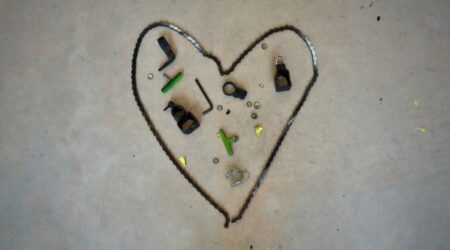
As our project, we transformed the “simple” act of fixing a bicycle into an introspective investigation of the concept of care and its implications. Within a few weeks, we collaboratively tried to bring life into a neglected two-wheeler. In all repairing sessions we took time for self-reflection, retracing the steps, thoughts and actions performed. By this, we tried to dig out the underlying patterns that are connected to our doing. Analysing the process brought up several challenges and questions. Is fixing the bike an act of care that we do towards the object, or towards ourselves? How are gender roles manifested in our actions? Can you break something as an act of maintenance? Is it necessary to receive care in order to perform an act of care? Is the concept of care an act of pure altruism, completely unrelated to any kind of end or return? Are we doing this project merely out of selfishness aimed at completing an assigned task to get a grade? What does care mean for us? Finally, the reflections were transformed into a video installation that will be displayed this Friday.
(No) More Stretch Please – Manifesto for (In)Flexibility
By Paula Kristiāna Veidenbauma, Jannik Kastrup, Luca Liese Ritter
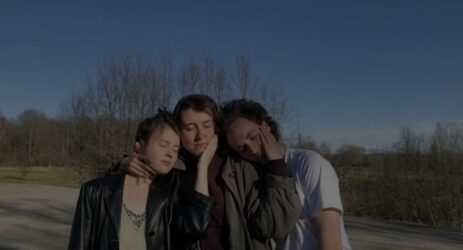
We have a problem. At the Estonian Academy of Arts, a room can become an exhibition hall, a hallway can be turned into a conference center, any of the concrete walls—into galleries, waiting for the next vernissage to start. The architecture of EKA’s new building bears unending potential imaginaries, designed as always hybrid, always adaptable, and ever-changing. But how much space is left for flexibility in the program designs? And how does it show in the program implementation? Does the immaterial system behind the space provide a flexible support mechanism for students when in need or is flexibility ultimately a false promise, disguising flaws within the university’s structure?
The project examines the relationship between the flexible-oh-so-flexible working environment and culture at the university and the systematic framework of program structures at the EKA Faculty of Architecture. Grounded in our own experience, observations and private stories of students, at times faced with the limits of the flexibility, The Manifesto for (In)Flexibility is both an attempt to gain visibility of the invisible sufferings at an institution deeply grounded within the landscape of neoliberal academia, as well as a manual on how to resist the institutional normalisation of overworking. Presented in a form of a performative reading, the project includes movement practices addressing space exploration, testing the limits of the flexibility of one’s body and those of the space, thinking, where would they meet.
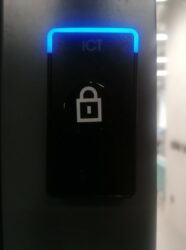
the door stop
By Nora Soo, Kush Badhwar, Khadeeja Farrukh
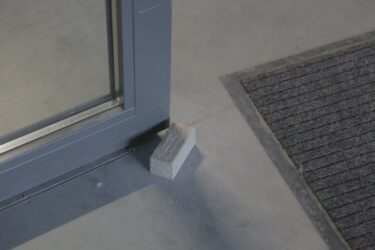
The new building for the Estonian Academy of Arts (EKA), made amongst the remains of an old textile factory, was opened for use in 2018. The ground for a newer EKA building is being prepared behind the current building. A new green sign, with the signature EKA typeface was erected to mark this site within the last week.
Part of the process of envisioning, designing and producing new and newer EKA buildings, is the narrativisation and historicisation of these sites, most visibly undertaken as marketing materials, often to attract new students to the university. the door stopis a zine that seeks to broaden narrativisation and historicisation of EKA through the observation, documentation, story-telling and imaginations of the building from the student perspective, with particular attention to use, care, appropriation, resistance, creative misuse, image-based intervention and other forms that fall outside of the intentions of the architect(s) and hegemony of the institution.
Composed of photography, text and sketches, the door stop, though limited to the perspective of three students, hopes to document the overlooked and the ephemeral; foster care, interest and engagement in the space amongst students + their future generations; and to possibly influence change in the production of further EKA buildings.
Looking for Action
By Christian Hörner, Paulina Schroeder, Nabeel Imtiaz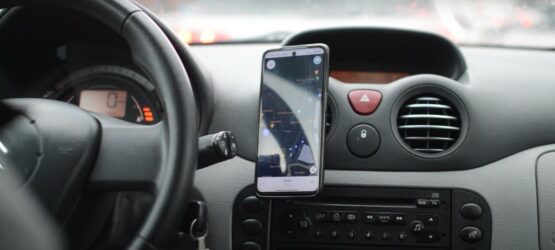
Techno-Ecologies of Care emerge throughout the entanglements between the courier, his mobile phone, the car, the food, and many other things, affording moments of caring for and about in this system of provision of life-sustaining matter. Our project tries to present illuminating documentation of the everyday work of a bolt food courier. These urban workers are often invisible, working under a highly neoliberal regime of platform capitalism. Also, they are directly exposed to novel algorithmic means which manage their routes and govern the relationship between couriers, restaurants, and customers which make up the urban space of food delivery. Our video emerged out of the empirical practice of participant observation and represents a methodical mixture of interview/conversation and active participation in the process of food delivery. We aim to shed light on the internalities of food delivery in the sense of capturing the potentially boring details of everydayness as proposed by Susan Leigh Star in her essay “The Ethnography of Infrastructure”.
Urban Ethnography – Technoecologies of care. Final presentations
Friday 29 April, 2022
Taking technoecologies of care in (hard or soft) urban infrastructure as a starting point, the Urban Ethnography course (tutors: Agata Marzecova and Hanna Husberg) uses ethnographic strategies to make perceptible interdisciplinary phenomena that cannot be described from a disciplinary perspective. During the course the participants are encouraged to develop collaborative research projects that explore boundary approaches to ethnography by critically employing creative and artistic research methods in the research process, as well as for conveying their research results.
Whereas ecology can be understood as a science of relatedness between things, beings and processes that make up urban nature or urban space, technoecologies allows an analysis of the entanglement of technologies and natures, and draws attention to how the materialisation of nature is always and already a mediated phenomenon. Subsequently, addressing care through its technoecologies allows for a prism through which human, non-human and technological elements are treated not as separate entities but as interrelated aspects of care, maintenance and repair.
The finals will start at 14:00 with four group presentations by students (abstracts below). This will be followed by a presentation starting at 17.30 by our external reviewer, Swedish-Brazilian artist, researcher, writer and Senior Lecturer in Media and Communication Studies at Södertörn University (Stockholm), Isabel Löfgren. Lögfgren often works in collaboration with artistic collectives and art institutions considering issues in visual, gender, social and environmental justice and her research interests include cultural politics, aesthetics, and the philosophy of migration and diaspora in the fields of contemporary art, media philosophy, and media activism.
Facebook event can be found HERE.
Pimp my bike
By Martina Maria Semenzato, Leonardo Improta , Paul Jochen Simon

As our project, we transformed the “simple” act of fixing a bicycle into an introspective investigation of the concept of care and its implications. Within a few weeks, we collaboratively tried to bring life into a neglected two-wheeler. In all repairing sessions we took time for self-reflection, retracing the steps, thoughts and actions performed. By this, we tried to dig out the underlying patterns that are connected to our doing. Analysing the process brought up several challenges and questions. Is fixing the bike an act of care that we do towards the object, or towards ourselves? How are gender roles manifested in our actions? Can you break something as an act of maintenance? Is it necessary to receive care in order to perform an act of care? Is the concept of care an act of pure altruism, completely unrelated to any kind of end or return? Are we doing this project merely out of selfishness aimed at completing an assigned task to get a grade? What does care mean for us? Finally, the reflections were transformed into a video installation that will be displayed this Friday.
(No) More Stretch Please – Manifesto for (In)Flexibility
By Paula Kristiāna Veidenbauma, Jannik Kastrup, Luca Liese Ritter

We have a problem. At the Estonian Academy of Arts, a room can become an exhibition hall, a hallway can be turned into a conference center, any of the concrete walls—into galleries, waiting for the next vernissage to start. The architecture of EKA’s new building bears unending potential imaginaries, designed as always hybrid, always adaptable, and ever-changing. But how much space is left for flexibility in the program designs? And how does it show in the program implementation? Does the immaterial system behind the space provide a flexible support mechanism for students when in need or is flexibility ultimately a false promise, disguising flaws within the university’s structure?
The project examines the relationship between the flexible-oh-so-flexible working environment and culture at the university and the systematic framework of program structures at the EKA Faculty of Architecture. Grounded in our own experience, observations and private stories of students, at times faced with the limits of the flexibility, The Manifesto for (In)Flexibility is both an attempt to gain visibility of the invisible sufferings at an institution deeply grounded within the landscape of neoliberal academia, as well as a manual on how to resist the institutional normalisation of overworking. Presented in a form of a performative reading, the project includes movement practices addressing space exploration, testing the limits of the flexibility of one’s body and those of the space, thinking, where would they meet.

the door stop
By Nora Soo, Kush Badhwar, Khadeeja Farrukh

The new building for the Estonian Academy of Arts (EKA), made amongst the remains of an old textile factory, was opened for use in 2018. The ground for a newer EKA building is being prepared behind the current building. A new green sign, with the signature EKA typeface was erected to mark this site within the last week.
Part of the process of envisioning, designing and producing new and newer EKA buildings, is the narrativisation and historicisation of these sites, most visibly undertaken as marketing materials, often to attract new students to the university. the door stopis a zine that seeks to broaden narrativisation and historicisation of EKA through the observation, documentation, story-telling and imaginations of the building from the student perspective, with particular attention to use, care, appropriation, resistance, creative misuse, image-based intervention and other forms that fall outside of the intentions of the architect(s) and hegemony of the institution.
Composed of photography, text and sketches, the door stop, though limited to the perspective of three students, hopes to document the overlooked and the ephemeral; foster care, interest and engagement in the space amongst students + their future generations; and to possibly influence change in the production of further EKA buildings.
Looking for Action
By Christian Hörner, Paulina Schroeder, Nabeel Imtiaz
Techno-Ecologies of Care emerge throughout the entanglements between the courier, his mobile phone, the car, the food, and many other things, affording moments of caring for and about in this system of provision of life-sustaining matter. Our project tries to present illuminating documentation of the everyday work of a bolt food courier. These urban workers are often invisible, working under a highly neoliberal regime of platform capitalism. Also, they are directly exposed to novel algorithmic means which manage their routes and govern the relationship between couriers, restaurants, and customers which make up the urban space of food delivery. Our video emerged out of the empirical practice of participant observation and represents a methodical mixture of interview/conversation and active participation in the process of food delivery. We aim to shed light on the internalities of food delivery in the sense of capturing the potentially boring details of everydayness as proposed by Susan Leigh Star in her essay “The Ethnography of Infrastructure”.
07.09.2022 — 20.11.2022
TAB Tallinn Architecture Biennial 2022
The main program of the Tallinn Architecture Biennale 2022 combines food and architecture
The 6th Tallinn Architecture Biennale “Edible; Or, The Architecture of Metabolism” invites architects and architecture enthusiasts to think about a sustainable future, where natural processes are used and waste is reduced.
Biennale curators Lydia Kallipoliti (Greece/USA) and Areti Markopoulou (Spain/Greece) in cooperation with Estonian adviser Ivan Sergejev and curator’s assistant Sonia Sobrino Ralston (USA) give architects, planners and environmental designers the opportunity to discuss and explore how through architecture it is possible to influence circular economy operations such as food and energy production and resource degradation.
TAB 2022 chief curators Lydia Kallipoliti and Areti Markopoulou are critical of the consuming and polluting human-made environment and invite to imagine an architecture that produces resources and uses and decomposes its waste. “Amid the current crisis of public health, climate change and social inequality, it is clear that the fragility of our supply chains requires new forms of local sourcing and production. TAB 2022 addresses the question of ‘where our food comes from’ as a creative design challenge and raises questions about the aesthetic, cultural and experiential qualities of the environment around us throughout its life cycle,” explained TAB 2022 chief curators Kallipoliti and Markopoulou.
Estonian Academy of Arts is happy to contribute to the versatile programme of TAB with international conference “Innovation and Digital Reality”, taking place on 6 September at EKA. Read more and sign up.
See the entire TAB 2022 program here: https://2022.tab.ee/et/programm/
The curatorial exhibition “Edible” brings together world-class designers and architects, whose works are divided into five thematic blocks: Metabolic Home, From Stone to Mull, Food and Geopolitics, Archeology of Architecture and Food Systems, and Future Food.
In addition, the chief curators have put together a 2-day “Edible” conference program for architects, designers and others interested in the space. The program includes exciting discussions about the importance of design in urban space, the effects of history on today’s environment, as well as discussions about the city of the future. The main speakers of the symposium will be Beatriz Colomina, the well-known author of design books, Andrés Jaque, the head of the design and research studio Effekt and the research center Office for Political Innovation.
As part of the TAB 2022 installation competition, the installation “Fungible Non Fungible” by IHEARTBLOB (Austria, UK, Estonia) will appear in front of the Estonian Museum of Architecture. It is the world’s first blockchain-financed architectural project. Their work gives a completely new dimension to the traditional role of an architect – an architect is no longer just a master, but a system designer who brings together innovative technologies, encouraging communities and local masters to be part of the creative process. For this, the IHEARTBLOB team is creating a NFT (Non-Fungible Token) platform where those who wish can design and buy a piece of the work. The result is a unique installation created and owned by different designers from all over the world. The platform for joint design of the installation will be opened in May.
The main program of TAB 2022 consists of five parts: a curatorial exhibition and an installation competition program at the Estonian Museum of Architecture, a 2-day symposium and a vision competition exhibition at the Kultuurikatel, and an international exhibition of architecture schools at the EKKM garden.
TAB 2022 invites all Ukrainian architects to participate in the TAB program free of charge. More information about free admission at info@tab.ee.
The main sponsor of the Tallinn Architecture Biennale 2022 is Thermory – the world’s largest manufacturer of chemical-free thermal wood, whose material has been used in outstanding projects in more than 50 countries around the world.
Supporters and partners of TAB 2022: Ministry of Culture, Cultural Endowment, European Development Fund, British Council, Onassis Culture, Visit Estonia, Association of Estonian Architects, Estonian Architecture Museum, Tallinn City Planning Board, IAAC, Friendship Products, Laufen, Ruukki, Velux, Tallink Hotels, Estonian Academy of Arts.
TAB Tallinn Architecture Biennial 2022
Wednesday 07 September, 2022 — Sunday 20 November, 2022
The main program of the Tallinn Architecture Biennale 2022 combines food and architecture
The 6th Tallinn Architecture Biennale “Edible; Or, The Architecture of Metabolism” invites architects and architecture enthusiasts to think about a sustainable future, where natural processes are used and waste is reduced.
Biennale curators Lydia Kallipoliti (Greece/USA) and Areti Markopoulou (Spain/Greece) in cooperation with Estonian adviser Ivan Sergejev and curator’s assistant Sonia Sobrino Ralston (USA) give architects, planners and environmental designers the opportunity to discuss and explore how through architecture it is possible to influence circular economy operations such as food and energy production and resource degradation.
TAB 2022 chief curators Lydia Kallipoliti and Areti Markopoulou are critical of the consuming and polluting human-made environment and invite to imagine an architecture that produces resources and uses and decomposes its waste. “Amid the current crisis of public health, climate change and social inequality, it is clear that the fragility of our supply chains requires new forms of local sourcing and production. TAB 2022 addresses the question of ‘where our food comes from’ as a creative design challenge and raises questions about the aesthetic, cultural and experiential qualities of the environment around us throughout its life cycle,” explained TAB 2022 chief curators Kallipoliti and Markopoulou.
Estonian Academy of Arts is happy to contribute to the versatile programme of TAB with international conference “Innovation and Digital Reality”, taking place on 6 September at EKA. Read more and sign up.
See the entire TAB 2022 program here: https://2022.tab.ee/et/programm/
The curatorial exhibition “Edible” brings together world-class designers and architects, whose works are divided into five thematic blocks: Metabolic Home, From Stone to Mull, Food and Geopolitics, Archeology of Architecture and Food Systems, and Future Food.
In addition, the chief curators have put together a 2-day “Edible” conference program for architects, designers and others interested in the space. The program includes exciting discussions about the importance of design in urban space, the effects of history on today’s environment, as well as discussions about the city of the future. The main speakers of the symposium will be Beatriz Colomina, the well-known author of design books, Andrés Jaque, the head of the design and research studio Effekt and the research center Office for Political Innovation.
As part of the TAB 2022 installation competition, the installation “Fungible Non Fungible” by IHEARTBLOB (Austria, UK, Estonia) will appear in front of the Estonian Museum of Architecture. It is the world’s first blockchain-financed architectural project. Their work gives a completely new dimension to the traditional role of an architect – an architect is no longer just a master, but a system designer who brings together innovative technologies, encouraging communities and local masters to be part of the creative process. For this, the IHEARTBLOB team is creating a NFT (Non-Fungible Token) platform where those who wish can design and buy a piece of the work. The result is a unique installation created and owned by different designers from all over the world. The platform for joint design of the installation will be opened in May.
The main program of TAB 2022 consists of five parts: a curatorial exhibition and an installation competition program at the Estonian Museum of Architecture, a 2-day symposium and a vision competition exhibition at the Kultuurikatel, and an international exhibition of architecture schools at the EKKM garden.
TAB 2022 invites all Ukrainian architects to participate in the TAB program free of charge. More information about free admission at info@tab.ee.
The main sponsor of the Tallinn Architecture Biennale 2022 is Thermory – the world’s largest manufacturer of chemical-free thermal wood, whose material has been used in outstanding projects in more than 50 countries around the world.
Supporters and partners of TAB 2022: Ministry of Culture, Cultural Endowment, European Development Fund, British Council, Onassis Culture, Visit Estonia, Association of Estonian Architects, Estonian Architecture Museum, Tallinn City Planning Board, IAAC, Friendship Products, Laufen, Ruukki, Velux, Tallink Hotels, Estonian Academy of Arts.

